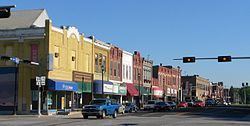Country United States Time zone Central (CST) (UTC-6) Zip code 68434 Local time Thursday 12:55 PM | Elevation 1,493 ft (455 m) Area code(s) 402 Population 7,120 (2013) | |
 | ||
Weather 5°C, Wind N at 27 km/h, 93% Humidity University Concordia University (Nebraska) | ||
Seward is a city and county seat of Seward County, Nebraska, United States. The population was 6,964 at the 2010 census. Seward is part of the Lincoln, Nebraska Metropolitan Statistical Area. It is known for its large Fourth of July celebration.
Contents
- Map of Seward NE 68434 USA
- History
- Geography
- 2010 census
- 2000 census
- Fourth of July City
- Education
- Notable people
- References
Map of Seward, NE 68434, USA
History
Seward was platted in 1868. It was named from Seward County. The railroad was built through Seward in 1873.
Geography
Seward is located at 40°54′40″N 97°5′49″W (40.911216, -97.096972). According to the United States Census Bureau, the city has a total area of 4.31 square miles (11.16 km2), of which, 4.27 square miles (11.06 km2) is land and 0.04 square miles (0.10 km2) is water.
2010 census
As of the census of 2010, there were 6,964 people, 2,521 households, and 1,653 families residing in the city. The population density was 1,630.9 inhabitants per square mile (629.7/km2). There were 2,796 housing units at an average density of 654.8 per square mile (252.8/km2). The racial makeup of the city was 96.8% White, 0.6% African American, 0.4% Native American, 0.6% Asian, 0.3% from other races, and 1.4% from two or more races. Hispanic or Latino of any race were 1.9% of the population.
There were 2,521 households of which 32.1% had children under the age of 18 living with them, 55.0% were married couples living together, 7.3% had a female householder with no husband present, 3.2% had a male householder with no wife present, and 34.4% were non-families. 30.2% of all households were made up of individuals and 15.4% had someone living alone who was 65 years of age or older. The average household size was 2.39 and the average family size was 2.98.
The median age in the city was 32.4 years. 22.6% of residents were under the age of 18; 18.8% were between the ages of 18 and 24; 21.5% were from 25 to 44; 22% were from 45 to 64; and 15.1% were 65 years of age or older. The gender makeup of the city was 48.1% male and 51.9% female.
2000 census
As of the census of 2000, there were 6,319 people, 2,281 households, and 1,494 families residing in the city. The population density was 1,930.9 people per square mile (746.1/km²). There were 2,415 housing units at an average density of 737.9 per square mile (285.1/km²). The racial makeup of the city was 97.97% White, 0.46% African American, 0.13% Native American, 0.47% Asian, 0.36% from other races, and 0.60% from two or more races. Hispanic or Latino of any race were 0.98% of the population.
There were 2,281 households out of which 31.7% had children under the age of 18 living with them, 55.6% were married couples living together, 7.3% had a female householder with no husband present, and 34.5% were non-families. 29.8% of all households were made up of individuals and 16.2% had someone living alone who was 65 years of age or older. The average household size was 2.39 and the average family size was 2.99.
In the city, the population was spread out with 22.6% under the age of 18, 20.1% from 18 to 24, 22.9% from 25 to 44, 17.9% from 45 to 64, and 16.5% who were 65 years of age or older. The median age was 32 years. For every 100 females there were 90.7 males. For every 100 females age 18 and over, there were 86.4 males.
As of 2000 the median income for a household in the city was $41,264, and the median income for a family was $54,808. Males had a median income of $33,828 versus $22,231 for females. The per capita income for the city was $17,668. About 4.1% of families and 6.6% of the population were below the poverty line, including 4.6% of those under age 18 and 5.3% of those age 65 or over.
Fourth of July City
Seward has celebrated the United States' July 4 Independence Day almost every year since 1868. In the past, before the automobile came into general use, special trains were run to bring people to the event. In 1973, Governor J. James Exon issued a proclamation designating Seward "Nebraska's Official 4th of July City"; in 1976, the city was chosen to host Nebraska's July 4 celebration for the United States Bicentennial; in 1979, a resolution in the U.S. Congress named Seward "America's Official Fourth of July City—Small Town USA". Recent attendance has been estimated at about 40,000.
Education
Seward Public Schools is the only public district in the city. It operates Seward Elementary School, Seward Middle School, and Seward High School. In addition St. John Lutheran Elementary and Junior High School provides a LCMS Lutheran education and St. Vincent de Paul provides a Roman Catholic education. Concordia University is located in Seward.
